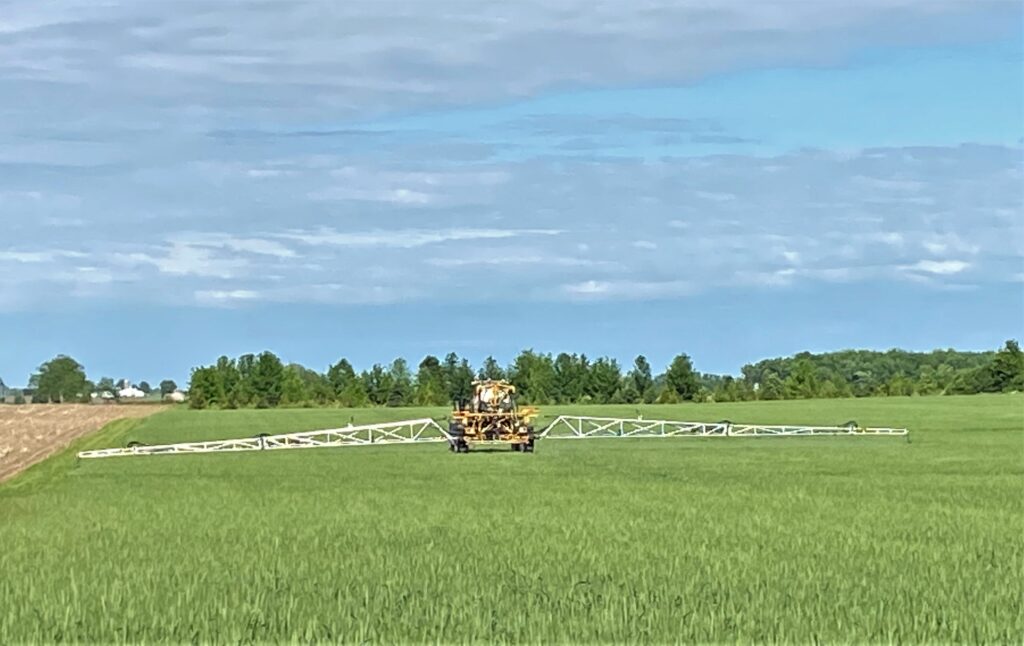Synopsis: The majority of the crop has been planted, with most of the remaining acres in the heavy clay soils of Lambton, Essex, Haldimand and Niagara. Growing conditions are good resulting in rapid crop growth. Sporadic rains over the region have left many area soils dry with hopes of rain later this week. Fields of winter wheat are at or near the stage for T3 fungicide applications with relatively low disease pressure to date. Weed control continues to be a challenge with high winds and rapid emergence resulting in switching from pre to post application options.

Field preparation: With a few days of good conditions, most planting should be completed by this weekend. Seedbed preparation to clay soils is leaving them lumpy and makes proper planting depth which is also . While emergence in most areas is good, there are a few pockets where there was some crusting and uneven emergence on clay soils and where rotary hoeing is preventing the need for replanting. In most areas a gentle half-inch rain would help emergence.
Soybeans: Over 60 percent of soybeans are planted, and many are emerging within a few days. Rolling or rotary hoeing should be done while beans are emerging but should wait for afternoon heat during V1 or V2 stage. Horst Bohner discussed observations to planting depth this year compared to results from studies done in previous years.

With conditions this spring a 3-inch seeding depth on loam soils emerged without issue, however on clay soils a half-inch planting depth was more effective. Setting planters for a 1 ½ inch depth target is the most sound advice.
Corn: Some of the best corn stands appear on stale seed-beds mostly due to better soil moisture. Side-dress nitrogen applications will be starting on earliest planted corn next week as corn growth progresses with warm temperatures. No shortages of nitrogen products are anticipated. Earliest planted fields at 4-leaf stage, and although most is emerging well, stands are not perfect. Reports of insect damage is low due to rapid emergence, although scouting for armyworm (reported in a few locations) and cutworm will be important for the next few weeks.

Wheat: Earliest planted wheat has headed and T3 fungicide applications are being applied. Uniformity of stands will make ideal timing more difficult, however application of fungicides even up to 7 or 8 days after heads emerge will provide some protection from DON. Disease pressure remains low.
Weed Control: With rapid crop emergence, weed control becomes a challenge, especially with windy conditions and temperature swings. Some growers have missed the window for pre-emerge herbicides. Although parking the sprayer during the heat of the day is the ideal option, especially when wind speeds are high, spraying safe products can be done when conditions allow but water volumes should be increased.
Peter Sikkema has observed dense stands of glyphosate resistant Canada Fleabane, especially in winter wheat fields. Is it being found in a wider geography and at higher densities? Does glyphosate applied with UAN as the carrier (compared to water) result in less consistent control? Studies done with UAN as a carrier in winter wheat often resulted in increased visual crop injury, even though it did not result in decreased yield. Farmers would be reluctant to use UAN as carrier with the resulting crop injury. UAN with glyphosate as a soil applied application is fine if it is applied uniformly. Dandelions seem to be more common in many fields this spring – some quite thick and some coming through after tillage. The rule of thumb for dandelion control based on Peter Sikkema’s research:
• 4-inch diameter – glyphosate at 900 gm/ha or 0.67 l/ac of Weathermax
• 6-inch diameter – increase rate to 1 l/ac Weathermax
• 8-inch diameter – increase rate to 1.34 l/ac Weathermax
However, research indicated that on a dollar for dollar basis, (pre glyphosate price increase) weed control is more effective in controlling dandelions by increasing the rate of glyphosate than tank mixing with another product in corn. In contrast for soybeans, a tank mix of glyphosate with the addition of Classic is an effective alternative where (0.67 l/ac glyphosate + Classic) will get dandelion control comparable to high rate glyphosate. Even when dandelion is the only weed present , earlier application is preferred to waiting for more weeds to grow since small weeds are always easier to control than big weeds with post emerge applications.
Horticulture Crops: Tomato planting is going smoothly and should be done by next week. Few problems have been reported except in areas that received hail. In these areas regrowth is good, however plants will be slightly delayed for harvest. Some reports of herbicide drift from glyphosate applications is a good reminder to watch wind direction and crops in downwind fields when applying herbicides. Sugar beets have generally emerged well. Some replanting has occurred in fields that were planted early and then had frost. There are some fields with varieties that have poor emergence. They will not be replanted even though the stand is lighter than ideal. Peas have been planted and are emerging well with uniform stands.
Crop Insurance: Leon provided the winter wheat status which remains unchanged from 2 weeks ago. Damage reports for soybeans have started to come in with 20 reports representing about 1870 acres injured mainly with excessive rain. Growers have until June 30 to make changes to coverage. Go to www.agricorp.com for additional information.
Diagnostic Days – July 20 and 21, 2022 – will be an in-person event at Ridgetown this summer on July 20 an 21st. Half-hour stops are scheduled, and more details will follow.